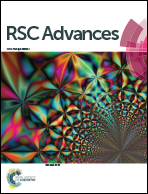Thiosemicarbazide chemical functionalized carbon dots as a fluorescent nanosensor for sensing Cu2+ and intracellular imaging
Abstract
Surface functionalization of nanomaterials with specific recognition units is a promising strategy to structurally novel nanosensors for target analysis and bioimaging. In this study, a fluorescent nanosensor has been successfully synthesized by conjugating thiosemicarbazide with carbon dots (CDs) through amide bonds. The functional CDs have a relatively narrow size distribution of about 1.6–4.0 nm. The CDs exhibit a highly specific recognition capability towards copper ions (Cu2+) over other competing metal ions, and the maximum quenching rate reaches 68.7%. A good linear correlation is also established between F0/F with the Cu2+ concentration ranging from 0 to 0.4 μM and the detection limit is 3.47 nM. On account of their strong fluorescence intensity, excellent water solubility, low toxicity and good biocompatibility the nanosensor demonstrates its biolabeling potential in vivo, which might have high significance in bioanalysis and biomedical detection in the future.


 Please wait while we load your content...
Please wait while we load your content...